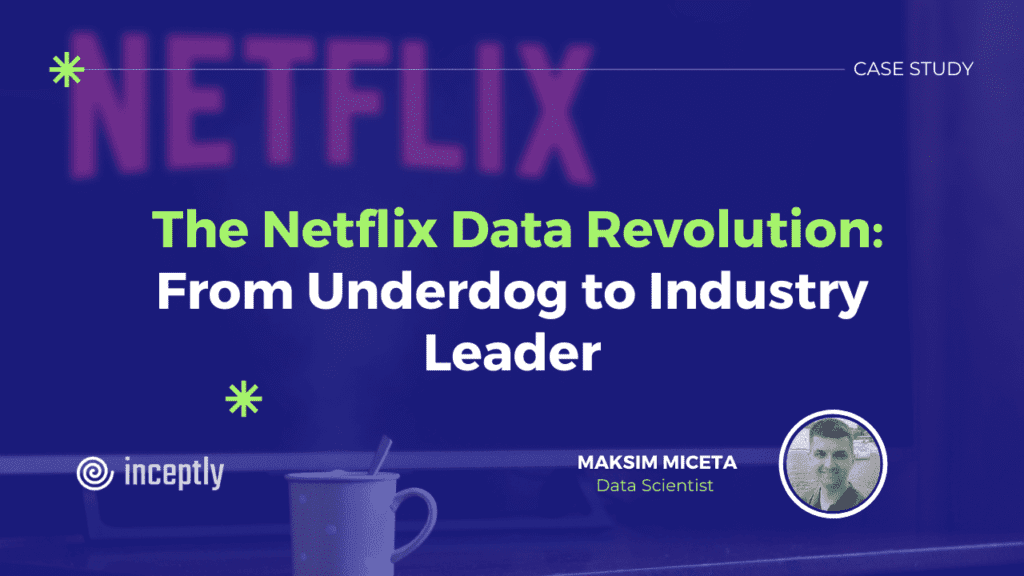
In the early 2000s, Netflix, a relatively small DVD rental company, was competing against the industry titan, Blockbuster.
Despite its smaller size and limited resources, Netflix began making a series of strategic moves that would unexpectedly transform the entire entertainment industry.
Against all odds, they began to outpace their gigantic rival. What could have been the hidden strategy behind Netflix’s remarkable ascent?
Want to brainstorm with our team on new ways to scale your business with YouTube Ads (and other performance video platforms)?
Join us for a free YouTube ad brainstorming session:
Challenging conventions with data
As the rivalry intensified, Netflix’s tactics seemed counterintuitive. While Blockbuster dominated with its vast network of physical stores, Netflix doubled down on a mail-order model, an approach that appeared outdated in the era of digitalization. Moreover, they introduced a subscription model, which was a stark contrast to Blockbuster’s per-rental fees. But was this just a bold gamble, or was there a method to this apparent madness?
Was Netflix’s success just a result of better marketing strategies, or was there a deeper, more profound reason? Some speculated that it might have been a lucky confluence of circumstances or simply a better selection of movies and series. Yet, the reality was much more intricate.
Data: The game changer

Netflix’s foray into the subscription model and its overall business strategy were grounded in meticulous data analysis. They recognized the growing customer dissatisfaction with Blockbuster’s late fees and leveraged data insights to offer a no-late-fee, flat-rate subscription service that catered to consumer preferences for a hassle-free movie-watching experience.
This data-driven approach didn’t stop at redefining the rental model; it extended to every facet of their business. Data was the guiding force from content acquisition and marketing to customer retention. Their boldest move, venturing into original content with the production of “House of Cards,” was also a calculated decision. Data indicated that the combination of Kevin Spacey, director David Fincher, and the political drama genre would resonate strongly with their audience, marking the beginning of a new era in entertainment.
Data discrepancies: Unravelling the marketing maze
This example of Netflix’s success story brilliantly illustrates the power of data in the digital era. Netflix didn’t just use data to understand its audience better; they transformed that data into decisive factors for strategic moves. Like Netflix, the digital marketing world thrives on the effective utilisation of data. The flood of data from countless sources represents both a goldmine and a labyrinth.
This flood of data, originating from an ever-growing number of channels, presents both an opportunity and a complex challenge. The clarity and accuracy of this data are not just beneficial but essential for success in today’s market. This discourse explores the pressing issues surrounding data reliability and the critical need for a sophisticated attribution platform capable of distilling vast data streams into veritable insights.
Data quality dilemma
In an industry where data dictates decisions, its integrity is paramount. The question is not whether you have data but whether you can trust its quality. How confident are you in the data that guides your marketing strategy?The multi-channel data puzzle
Understanding the performance of each marketing channel is a fundamental requirement. Yet, marketers often encounter a jigsaw puzzle of data, each piece from a different channel offering a different version of the story. Have you ever reconciled these pieces only to find a picture that doesn’t quite fit together?The misstep of misplaced trust
There’s a common pitfall on the path to unified data: the allure of 3rd party tools that promise much but deliver little. While they claim comprehensive tracking, the reality is often a tapestry woven with over-reported and misaligned data threads. Why settle for an illusion of effectiveness when what you need is the solid ground of truth?A single source of truth
Imagine a solution that serves as the single source of truth for all your marketing endeavors, providing a consolidated view that resonates with the actual financial health of your campaigns. It’s about connecting every dot in the landscape of your marketing efforts, from ad spend to bank statements.Beyond data scepticism
Scepticism about data is healthy until it becomes a hurdle. The challenge is to move beyond doubt and invest in a solution that ensures the data is not just transparent and accurate, but also tailored to the unique blueprint of your business, avoiding the costly detour of one-size-fits-all tools.
Platform power: Navigating through top attribution solutions

As the market responds to the need for precise marketing analytics, several tracking and attribution platforms have risen to prominence. Names like Hyros, Wicked Reports, RedTrack, Triple Whale, and SegMetrics are often at the forefront of the conversation. These platforms share a core set of tools designed to navigate the digital marketing landscape:
Pixels
Acting as the digital eyes across your sales funnel, pixels are the tracking technology that feeds data back to the platform.Connectors
These are the integrations with various marketing channels and tools, from ad platforms to CRM systems, forming a comprehensive data ecosystem.Data processing
Utilising Data Warehouses and SQL queries, these platforms organise and interpret vast amounts of information.Visualisation
Turning raw data into readable charts and graphs, data visualization is key to understanding your marketing metrics at a glance.
A universal solution with limitations
Despite their sophistication, these platforms tend to treat all businesses as if they were cut from the same cloth, crafting a solution intended to work universally. Yet, the uniqueness of each business often defies this one-size-fits-all approach. The reality is that while these tools offer Pixels, Data Warehousing, SQL query capabilities, and data visualisation, these are resources that are fundamentally accessible to businesses without the premium price tag.
In essence, these platforms are selling a concept that’s already within reach, repackaged as a premium service. It’s akin to the clever marketing of eggs as a premium product for children despite them being ordinary eggs. The narrative we need to craft is one that demystifies these offerings, showing that what is often sold as an exclusive service is, in reality, a well-marketed bundle of accessible tools.
Not a perfect fit? The drawbacks of attribution platforms
Even the most sophisticated tracking and attribution platforms are not exempt from drawbacks. Here’s a more organised exploration of the challenges they present, which often go unnoticed amidst the allure of ‘premium’ solutions.
Ownership and customization
Rigid structure
Built for automation and high-volume client management, these platforms can lack the flexibility to mould to the unique contours of your business’s needs, from funnel architecture to specific KPIs.Data ownership
There’s a hidden cost to not owning your data — when it’s stored on external platforms, you’re at the mercy of their terms and conditions, risking data security and sovereignty.
The high cost of assembled solutions
Opaque pricing
Costs are often disclosed post-consultation, tailored to the size of the business, which can escalate quickly, reflecting not the intrinsic value but the marketed value of assembled readily available tools.The premium egg scenario
Much like ordinary eggs marketed as premium products, these platforms combine accessible tools and sell them as an exclusive package at a premium. The high price often reflects the packaging, not the product.
Conclusion
In recognizing the inadequacies of one-size-fits-all attribution platforms, savvy businesses are turning away from overpriced and rigid systems that don’t deliver on their promises. The quest for a truly effective solution — one that is adaptable, cost-efficient, and allows full control over one’s data — is not just a preference; it’s a strategic imperative for growth and success in the ever-evolving digital marketplace.
Like this post? Let's continue the conversation!
Get in touch with us by shooting us a quick email or tagging us on LinkedIn or Instagram, and sharing your thoughts. Your feedback helps us keep our blog relevant and interesting.

Maksim Miceta, Data Scientist
Hailing from the world of science, Maksim excels at making sense of data. His superpower is extracting valuable insights that allow us to optimize media spend and the effectiveness of ad campaigns.
Want to brainstorm with our team on new ways to scale your business with YouTube Ads (and other performance video platforms)?
Join us for a free YouTube ad brainstorming session:



